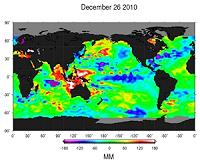| . |  |
. |
Majuro (AFP) Feb 20, 2011 Extreme high tides have flooded parts of the low-lying Marshall Islands capital Majuro with a warning Sunday of worse to come because of rising sea levels. Several areas of the city were flooded Saturday and forecasters predicted more to come on Sunday evening before the current high tide levels ease. Flooding of the Marshall Islands atolls, many of which rise less than a metre (three feet) above sea level, will increase in "frequency and magnitude" in the coming years, University of Hawaii marine researcher Murray Ford said. Ford, who is studying rising sea levels in the Marshall islands, said the weekend's extreme tides of 1.67 metres were exacerbated by La Nina, a weather phenomenon that has caused the base sea level to rise by 15 centimetres (six inches) in recent months. "As the sea level is temporarily higher as a result of La Nina and overlies long-term sea level rise, the impacts are magnified," Ford said. "While these events happen only a handful of times a year at present they will continue to increase in both frequency and magnitude." Ford said a gauge measuring long-term sea level changes at Majuro indicated the "average sea level is more than six inches above predicted" levels. The Marshall Islands, a collection of coral atolls and islands, announced plans late last year to build a wall to hold back rising sea levels around Majuro which is home to nearly half of the country's 55,000 population. Overcrowding in the urban centre have forced people to build homes within a couple of metres of the shore, increasing their exposure to flooding during peak tide periods.
Share This Article With Planet Earth
Related Links Water News - Science, Technology and Politics
 A La Nina Like No Other Or Just A Big One
A La Nina Like No Other Or Just A Big OnePasadena CA (JPL) Feb 11, 2011 1. What is La Nina and why does it matter? La Nina, "little girl" in Spanish, is the cool part of a naturally-occurring climate cycle called the El Nino/Southern Oscillation. El Nino is the warm part at the other end of that cycle. These shifts are governed, like much of the climate on the planet, by the relationship between winds and ocean surface temperatures. When trade winds, blowing f ... read more |
|
| The content herein, unless otherwise known to be public domain, are Copyright 1995-2010 - SpaceDaily. AFP and UPI Wire Stories are copyright Agence France-Presse and United Press International. ESA Portal Reports are copyright European Space Agency. All NASA sourced material is public domain. Additional copyrights may apply in whole or part to other bona fide parties. Advertising does not imply endorsement,agreement or approval of any opinions, statements or information provided by SpaceDaily on any Web page published or hosted by SpaceDaily. Privacy Statement |